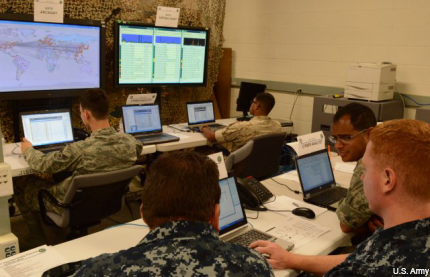Even in communications exercises, the cyberattacks are real
The Army-run JUICE, in which military, civilian and international components test joint emergency response, also draws the attention of hackers.

Multi-service personnel work in the Joint Cyber Center during JUICE.
When the Army set up its latest worldwide emergency communications exercise, it enlisted pretty much the full spectrum of partners, including joint U.S. forces, NATO allies, the National Guard, Homeland Security Department agencies, industry and first responders from around the United States. But one thing they didn’t need was a red team to test the security of their communications. If you build a network, the hackers will come.
The Army’s Communications-Electronics Command, or CECOM, at Aberdeen Proving Ground, Md., served as the hub for the month-long exercise, called the Joint Users Interoperability Communications Exercise, or JUICE, the Army said in a release. But about 90 percent of participants operated remotely, communicating via network services provided by the Defense Information Systems Agency.
One of the purposes of the annual JUICE exercise is to test communications security, and the idea of using a red team to conduct cyberattacks during the exercise has been discussed. However, “we don’t need a red team,” John Kahler, an Army civilian and team lead for the Joint On-demand Interoperability Network, said in the release. "We've got plenty of red players out there attempting to get into our network. We're in the middle of a battle right now," he said during the exercise.
The network got more than 3 million hits during the exercise, including attempts to hack into the network to monitor communications or install malware. Uniformed personnel—many of them National Guard or Reserve members with civilian jobs in IT—responded to the attacks while working in JUICE’s Joint Cyber Center and Joint Network Control Center, the Army said.
It’s just par for the course—attacks occur every year during JUICE, and the rate of attacks goes up each year, the Army said.
But as attacks have increased, so have situational awareness and the interoperability of communications. And this year was the first time since JUICE was started 21 years ago that all components—the services, state emergency centers, first responder, allies and other partners—communicated seamlessly, Kahler said.
That’s been a goal through the years. Even though the Army sees JUICE and joint communications in general in primarily military terms—the exercise also included the Joint Staff’s multinational Bold Quest exercise—it still recognizes the need to work with civilian organizations in emergencies. The Army noted that after events such as the 9/11 attacks and the 2010 earthquake in Haiti, the mix of responders who arrived from different military and civilian organizations had trouble communicating.
In this year’s exercise, which included an earthquake-and-power-outage scenario, what the Army described as special multimedia software helped the range of participants communicate using their own gear. Teams at some locations around the world also used solar power for uninterrupted communications, the army said.
Participants in JUICE were brought together under the Defense Support of Civil Authorities, a policy DOD released in March 2013 that sets the department’s priorities through 2020 for supporting civilian authorities, and would be activated in the event of a real emergency.




